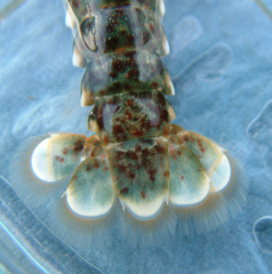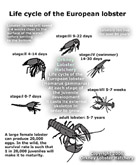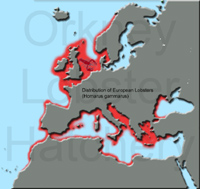Orkney Lobster Hatchery
European lobster (Homarus gammarus)

.jpg)
The natural range of the European lobster is the eastern Atlantic Ocean from the Lofoten Islands in northwestern Norway to the Azores and Morocco. It can also been found in the Mediterranean Sea west of Crete and in the northwestern parts of the Black Sea, but not in the Baltic Sea. It is rarely found deeper than 50m,
but can be found anywhere from the low tide mark to 150m, on hard substrates made of rock or mud.
The European lobster is slightly smaller on average than the closely-related American lobster, Homarus americanus, with a maximum recorded length of 1.26m, and weights of up to nearly 19 kg. However, such giants are rarely seen, and lengths of 23-50 cm with weights of around 0.7 kg are typical. At the minimum catch size (a carapace length of 87 mm in the British Isles ), European lobsters are estimated to be 5-7 years old, with the largest specimens being more than 50 years old.
.jpg)
The European lobster is solitary, nocturnal and territorial, living in holes or crevices in the sea floor during the day. In the summer, lobsters seek mates, and these migrations are the peak time for lobster fishery. The eggs are then carried by the female for around eleven months, meaning that egg-bearing females may be found throughout the year. After hatching, the planktonic larvae are released. These spend approximately 2-3 weeks in the water column. They then settle out of the water column and burrow into the seabed where they spend approximately 2 years. At a carapace length of about 15 mm they leave their burrows for crevices in rocky substrate. The smallest lobsters to be encountered in lobster pots are around 15 cm long. Maturity (and minimum landing sizes) tend to be reached after 4-5 years.
The diet of the adult European lobster comprises mostly sea-bottom invertebrates such as crabs, molluscs, sea urchins, polychaete worms and starfish, but may also include fish and plants. When moulting, lobsters eat a greater proportion of sea urchins and starfish, as a source of calcium. Feeding is reduced in the winter because of the slower metabolic rate brought on by the lower sea temperatures.
The diet of the adult European lobster comprises mostly sea-bottom invertebrates such as crabs, molluscs, sea urchins, polychaete worms and starfish, but may also include fish and plants. When moulting, lobsters eat a greater proportion of sea urchins and starfish, as a source of calcium. Feeding is reduced in the winter because of the slower metabolic rate brought on by the lower sea temperatures.

Saturday, 13 February, 2010 Orkney Lobster Hatchery all photos copyright Dennis Gowland

